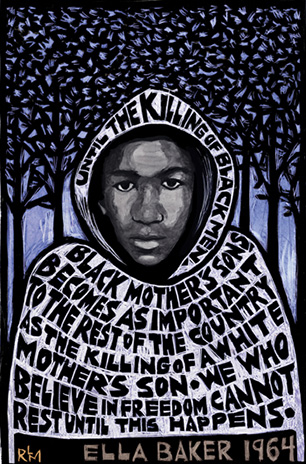If anything positive has come from George Zimmerman’s “not guilty” verdict in the murder of 17-year-old Trayvon Martin, it might be that the trial’s outcome has led to an explosion of cultural resistance in the form of performance arts and media strategies that are continuously raising consciousness about the intersecting issues of racial justice, police brutality and mass incarceration.
It’s a cultural resistance movement grounded in the arts that has used the profiling of Martin in vivid murals displaying him adorned in his now-prominent hoodie, as well as online, by making the tag #hoodiesup one of the most popular hashtags on Twitter and across other social media platforms.
In fact, the movement has “memed” the symbol Martin has become so well that a museum director at the Smithsonian Institution in Washington, D.C., has expressed interest in acquiring the garment for display.
“Art is the raw material of consciousness, and that’s the lever on which social change balances. This puts us right at the center of the project of social change and really makes all organizing a subset of cultural work,” says Ricardo Levins Morales, a social justice artist. “[Artists’] role in moments like this is not just to capture the moment and express people’s feelings, but help to transform it from a moment that’s about expending energy to one that’s about accumulating power.”
Morales created a visual piece just after the Zimmerman verdict came down. The artwork combines a display of Martin alongside the historical perspective of Ella Baker by using her words from 1964 about the value of black mothers’ sons as well as an explication of future change.
Morales believes cultural resistance should focus on going beyond flashpoints in history that spark mass protest and work toward harnessing the energy borne out of anger into confronting a more enduring and underlying hopelessness that prevents many from working toward social justice in the long term. That’s why he was explicit about combining the perspectives of the past, present and future in his artwork.
Zimmerman’s acquittal on July 13 in shooting Martin, an unarmed, Black teen, initiated a national dialogue about equal justice, racial profiling, gun control and “Stand Your Ground” laws, and sparked protests and rallies nationwide calling for a civil rights probe and federal charges against Zimmerman.
But the national dialogue has been facilitated, at least in part, by a growing presence of artwork and other cultural signifiers surrounding the Zimmerman verdict, which have fundamentally changed the context in which the debate about racial justice operates.
With so much of the debate taking place online, organizers have been implementing social media strategies that have been able to get to the heart of the issue. One campaign participating in changing this context is Black Lives Matter. The campaign is in the format of call and response, part of the Black tradition. The campaign is both a call to action and a response to the ways in which Black lives have been devalued in the larger culture.
“For us, Black Lives Matter is a political and cultural intervention,” says organizer Alicia Garza. “We’re doing this political intervention through our work on the ground, but the cultural strategy is really important, and it’s intended to help amplify and shift the hegemony that exists in this country.”
The Black Lives Matter campaign follows on the initial social media explosion that started on the night of the Zimmerman verdict, which saw a number of Martin-related hashtags trend on Twitter and across other social media platforms. The campaign hopes to keep the conversation going in a way that fosters a larger push for change.
Melanie Cervantes, an activist and artist with the group Dignidad Rebelde, has seen how artwork can create a larger cultural framework that can transform anger into power. She witnessed firsthand how windows were broken in the streets of Oakland in the aftermath of the Zimmerman verdict. Her group, alongside another collective muralist group, painted a large mural to cover over one place where a window was broken, taking the news coverage back from property damage and insurance rates to community collaboration and the struggle for equality.
“People get inundated with anywhere from three to 20,000 advertisements a day, so we really feel like we have to create work that is in alignment with people’s values, with their vision and kind of interrupt the bombardment of crap that we see that really serves corporate interests,” says Cervantes.
Martin was number 31 out of a total of 313 people of color who were extra-judicially killed in 2012, according to a report from the Malcolm X Grassroots Movement, but his life continues to resonate around street corners and in plays, songs and memes in a larger cultural backlash that has transformed his story from a tragic statistic into an insatiable hunger for justice.
Thank you for reading Truthout. Before you leave, we must appeal for your support.
Truthout is unlike most news publications; we’re nonprofit, independent, and free of corporate funding. Because of this, we can publish the boldly honest journalism you see from us – stories about and by grassroots activists, reports from the frontlines of social movements, and unapologetic critiques of the systemic forces that shape all of our lives.
Monied interests prevent other publications from confronting the worst injustices in our world. But Truthout remains a haven for transformative journalism in pursuit of justice.
We simply cannot do this without support from our readers. At this time, we’re appealing to add 50 monthly donors in the next 2 days. If you can, please make a tax-deductible one-time or monthly gift today.
